

Introduction
The Nikon D5300 is a new 24.2 megapixel DSLR camera with no optical low-pass filter that can record Full HD movies at 1080/50/60p with stereo sound and comes equipped with built-in Wi-Fi and GPS. A high-resolution 3.2-inch vari-angle LCD monitor makes it easier to compose your shots from difficult angles, while the extensive ISO range of 100-25600 should cope with virtually all lighting conditions. A 5fps burst shooting mode, EXPEED 4 image processor, 39-point autofocus system with nine cross-type sensors, 2,016-pixel RGB metering sensor, High Dynamic Range mode, Active D-Lighting, and nine different special effects for stills and movies complete the Nikon D5300's headline specs. Available in three colours, black, grey and red, the Nikon D5300 costs £729.99 / $799.95 / €899 body only, or £829.99 / €1029 with the 18-55mm VR kit lens, and $1,399.95 with the AF-S NIKKOR 18-140mm f/3.5-5.6G ED VR lens.
Ease of Use
The Nikon D5300 replaces the year-old D5200 as the new mid-range model in Nikon's extensive DSLR line-up, slotting in between the existing D3200 and D7000 models, not only in terms of feature set and functionality, but also in terms of size and weight. It isn't quite as compact and lightweight as the D3200, but neither is it as bulky and heavy as the D7000. In comparison to its predecessor, the D5300 is slightly smaller and lighter than the D5200. The right-hand grip is deep and therefore quite comfortable for photographers with large hands and/or longish fingers, and there's also a handy rubberised thumb rest on the back of the body.
The D5100's 24.1 megapixel CMOS sensor has been superseded by a 24.2 megapixel sensor with no optical low-pass filter, which promises to deliver slightly finer details. The sensor can clean itself by way of high-frequency vibrations that will, at least in theory, shake off any non-adhesive dust particles that may have settled on the low-pass filter during a lens change. You can specify, via an option in the Setup menu, whether you want sensor cleaning to take place at shutdown, startup, both or neither, with the default being 'both'. The cleaning process pleasingly has no practical impact on startup times, which were near instant. The new image sensor is complemented by the more powerful EXPEED 4 processing engine and a larger buffer as well.
The D5300 is the first Nikon DSLR to offer both built-in wi-fi and GPS connectivity, instead of relying on optional accessories like all previous models. The wi-fi function essentially pairs the D5300 with an iOS or Android smartphone or other smart device, and allows you to eidt and share images directly to social networking sites like Facebook, Instagram, or Twitter. It also makes it possible to control the D5300 remotely via a smart device using the free Wireless Mobile Utility app, and set the focus point using the smart device's touchscreen. The built-in GPS/A-GPS receiver logs location information such as latitude, longitude, and altitude in the image's EXIF data, even when the camera is turned off, allowing you to retrace your steps even when you're not taking photos.
The 18-55mm f/3.5-5.6 VR kit lens that Nikon supplied feels fairly well-balanced on the Nikon D5300 and it fits into place with a reassuring mechanical click. It also adds the very important advantage of Vibration Reduction. Nikon bodies don't offer any form of in-camera image stabilisation, unlike similar models from Sony, Pentax and Olympus, so the affordable 18-55mm VR lens is a good starting point if you don't already have any Nikon lenses.
The shutter release action on the Nikon D5300 is surprisingly quiet, with a dampened mirror slap that makes this DSLR actually quieter than some rangefinder cameras. Furthermore, there is a Quiet Shutter Release mode, in which the mirror is raised fairly slowly to further reduce the sound it makes. This does, however, introduce some shutter lag, which usually isn't worth the few decibels of difference versus what is already an impressively quiet shutter.
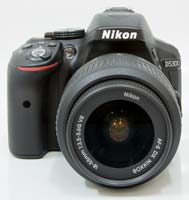
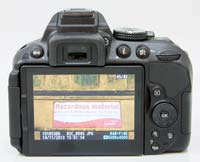 FrontRear
FrontRear The Nikon D5300 follows conventional DSLR design in having a shooting mode dial on the top of the camera, which allows you to select either one of the advanced modes like Manual, Aperture- or Shutter-priority, or a number of scene modes. The Exposure Compensation button is thoughtfully positioned next to the shutter release. Hold down this button with your right forefinger and spin the control wheel on the top-rear of the camera with your thumb to adjust its settings - simple and intuitive.
The Effects shooting mode, first introduced on the D5100, now provides 9 different filters that can be applied to both still images and movies. The Night Vision effect is particularly worth of mention, pushing the camera's sensitivity to a whopping ISO 102,400, although a monochrome rather than colour image is recorded. For stills, you can enter Live View mode to preview the effect or simply use the optical viewfinder. For movies, the recording is slowed down (dependent upon the chosen effect) as the camera uses a lot of processing power to apply the effect, leading to footage that can have a rather staccato feel. Note also that the camera sets virtually everything in the Effects mode - exposure, shutter speed, white balance, ISO, file type and quality - so its only creative in terms of the arty effect that's applied. Several of the same effects can be applied to an image or movie that you've taken, though, so you can have the best of both worlds (albeit without the luxury of a preview).
The second button sitting next to the shutter release is labeled 'info'. This button is arguably at the heart of the Nikon D5300's ease-of-use, as like its predecessor the camera lacks the monochromatic status LCD of the older D90, so Nikon had to provide a different way to check vital shooting information without having to look into the viewfinder. Enter the info button - pressing it displays virtually all of the camera's main settings on the large rear screen. Pressing the "i" button on the rear of the D5300 then allows you to interact with and set the onscreen options, with 14 available in total.
The rear articulated LCD screen is hinged at the side rather than the bottom. This fully articulated design is a much more flexible solution, allowing the screen to be folded out from the left side of the camera and folded inwards to protect it when not in use. The screen is slightly bigger than the D5200 at 3.2 inches and higher resolution too, with 1,037k dots, so there's nothing to complain about in this department. The screen also has an anti-glare coating, so that it's usable most of the time outdoors in strong daylight, although it still struggled a little with reflections.
The D5300's Live View is accessed in a different and arguably less intuitive way than on the D3200/D7100. Instead of a combined switch / button on the D3200/D7000, the D5300 has a fore-finger operated spring-loaded switch on top of the body that is pushed downwards and toggles between turning Live View on and off. Positioned next to the Shooting Mode dial, it allows you to enable Live View whilst holding the camera at arms length with one hand, or to turn it off as you hold the camera up to your eye. We'd prefer it to be on the rear of the camera and also to incorporate the Movie record button, in keeping with the D3200/D7100 models.
Press the Lv switch and the mirror flips up, the shutter opens and the rear screen displays the scene as seen through the lens. There is a red rectangle in the middle, which you can move practically anywhere in the frame. When in manual focus (MF) mode, you can magnify into this rectangle in a number of steps by repeatedly pressing the button marked with a loupe icon, but this magnification seems to be at least partially interpolated. This means that you cannot see detail down to the pixel level, unlike some competing cameras.
Fortunately, MF is not the only focusing option in Live View, at least as long as you are taking stills. Single-servo AF (AF-S) and Full-time-servo AF (AF-F) modes are also available and, while slow, they tend to be accurate. Both modes can also be used in connection with face detection. 'Face-priority AF' had no problem finding and keeping track of human faces as long as they were facing the camera, but acquiring focus was another story - very, very slow.
Live View must also be entered to shoot movies. After pressing the Lv button and optionally presetting the aperture and focus, you can start recording video by pressing the dedicated Movie Record button on top of the camera next to the shutter release. The camera records full high-definition, wide-screen video in 1920x1080 pixel resolution, at a frame rate of 60p/50p/30p/25p/24p, in AVI format using the motion JPEG codec. As with Live View, contrast-detect AF is possible whilst shooting movies, although as with still images there's an audible whine as the camera refocuses and it's still too slow to focus on any fast-moving subject, so much so that we suspect most serious users will use manual focusing instead. Although the D5300 can automatically focus during video recording, it's just not fast enough to warrant regular use.
You can set both the aperture and the shutter speed during movie recording, although the slowest shutter speed is limited to 1/30th second, plus exposure compensation and AE-Lock can also be set. Out of the box the D5300 can record stereo sound via its built-in microphone with three different levels of sensitivity on offer, and improved sound can also be recorded using an optional external microphone. The maximum size of a single video clip is 2 gigabytes which, given that movies occupy about 100 megabytes of storage space per minute, would theoretically translate into about 20 minutes of continuous recording.
The D5300 has a proper through-the-lens optical viewfinder with a slightly improved magnification of 0.82x, on par with most of its rivals. The Nikon D5300's 39 auto-focus points are permanently marked on the focusing screen, whereas the compositional grid lines can be called up via a menu option. Two warning signs - telling you that the battery is running low or you have forgotten to insert a memory card - may also appear in the form of overlaid icons when appropriate. Below the finder is a traditional monochromatic status bar showing practically all relevant shooting information (including the ISO sensitivity, if so specified in the menu).
As stated above, the Nikon D5300 has 39 auto-focus sensors, out of which 9 are cross type. The other thirty are of the line variety, consequently being only sensitive to either vertical or horizontal detail, but not both. In practice, this did not turn out to be a real problem, with the camera typically locking focus on the subject quickly and easily, no matter which AF point was selected. In the viewfinder, the active AF point appears in red, which is easy to see. Selecting the active AF point is done by way of the four-way pad - except if you choose Auto Area AF - again a simple and intuitive solution. In low light, the AF sensors are helped by an AF assist lamp located on the front plate of the camera.
The 2,016-pixel RGB metering sensor used by the D5300 is again identical to the system used by the more expensive D7100 model. This provides precise data to the camera's Scene Recognition System, which optimises exposure, autofocus and white balance immediately before the shutter is released.
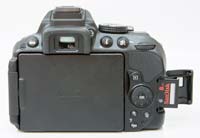
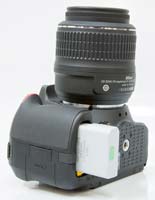 Memory Card SlotBattery Compartment
Memory Card SlotBattery Compartment The Nikon D5300 only has one control wheel and there are no dedicated buttons for controlling ISO sensitivity, white balance, metering or AF mode. The Fn button can be reprogrammed to perform ISO selection or white balance adjustment (or one of a few other functions such as file quality specification), but the others still have to be set through the main info screen, called up by pressing the [ i ] button top-right of the rear display. With practice, performing adjustments via this screen becomes fairly quick and easy, but it's not as efficient as the older D90's dedicated controls.
Most of the camera's rear controls are scattered, seemingly almost randomly, to the right of the D5300's large folding screen. While we can understand the need to locate them to accomodate the 3 inch LCD, the positioning of the Zoom In and Zoom Out buttons in particular isn't very intuitive, being operated with your right-hand thumb, and right next to the Delete button. As the D5300 isn't a very complex camera in terms of the number of external controls, it thankfully doesn't get too confusing, but is something to consider from an ergonomic point of view.
For the images that you've already already captured, the Nikon D5300 offers a broad range of retouching tools, including post-capture D-lighting (useful if you forgot to turn on Active D-lighting before capture), red-eye correction, trimming, monochrome conversion, different filter effects, colour adjustments, image resizing, image overlay, in-camera raw processing, quick auto retouching, straightening of crooked pictures, lens distortion correction, fisheye, colour outline, colour sketch, selective colour, miniature effect, and perspective control. Many of these functions make it unnecessary to buy specialised computer programs or plug-ins and spend hours in front of a computer to achieve a desired/popular effect.
The Nikon D5300 is powered by a proprietary EN-EL14a Lithium-ion battery, good for 600 shots, and records videos and image files on SD/SDHC/SDXC cards. As we noted in our D5200 review, we would really have liked to see Nikon add a second card slot for Compact Flash cards, so that owners of higher-specified Nikon DSLRs who buy a D5300 as a second body can use their existing memory cards. It also lacks the dual-SD slots of the D7100. As far as connectivity goes, there are USB/VideoOut and Mini HDMI ports as well as an accessory terminal for the connection of a wired remote or a GPS unit, all sheltered behind a door on the left side of the camera, when viewed from the back.
That concludes our look at the D5300's interface and feature-set. Now let's take a look at the D5300's image quality...
Entry Tags
Source: Photographyblog
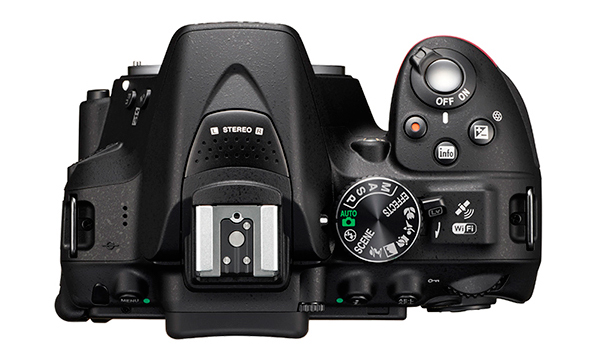 Image: The top of the camera houses only a few control points, keeping the layout simple and unintimidating for newcomers. A stereo microphone lives in front of the hotshoe
Image: The top of the camera houses only a few control points, keeping the layout simple and unintimidating for newcomers. A stereo microphone lives in front of the hotshoe 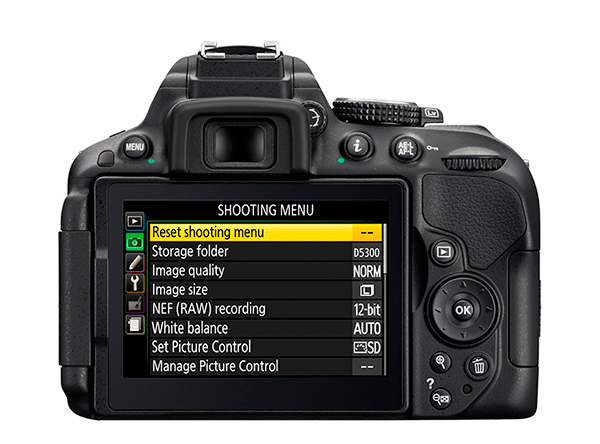 Image: The body styling will be familiar to those used to the Nikon 5000 series, as will the standard menu. The 3.2in flip-out screen has impressive visibility
Image: The body styling will be familiar to those used to the Nikon 5000 series, as will the standard menu. The 3.2in flip-out screen has impressive visibility  Image: Nikon has retained its choice of layouts for the rear-screen display, with text-based and graphically expressed options to suit personal preferences
Image: Nikon has retained its choice of layouts for the rear-screen display, with text-based and graphically expressed options to suit personal preferences 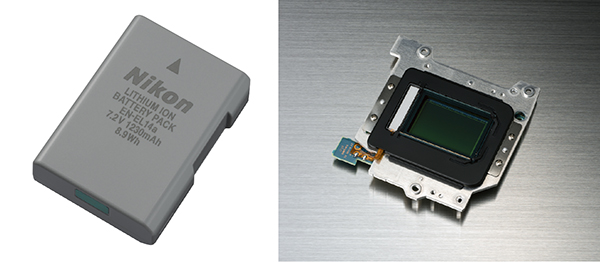 Image: The new battery, which is backwards compatible with the D5200, offers a longer life. There is no low-pass filter on the sensor, for extra resolution
Image: The new battery, which is backwards compatible with the D5200, offers a longer life. There is no low-pass filter on the sensor, for extra resolution